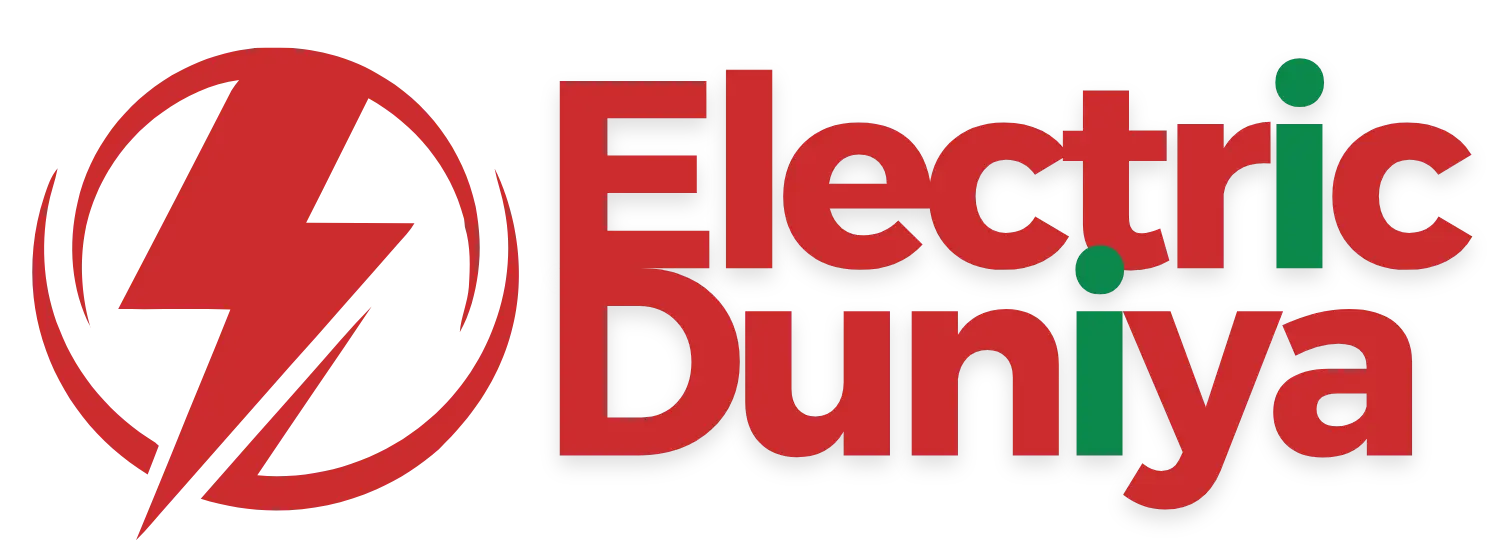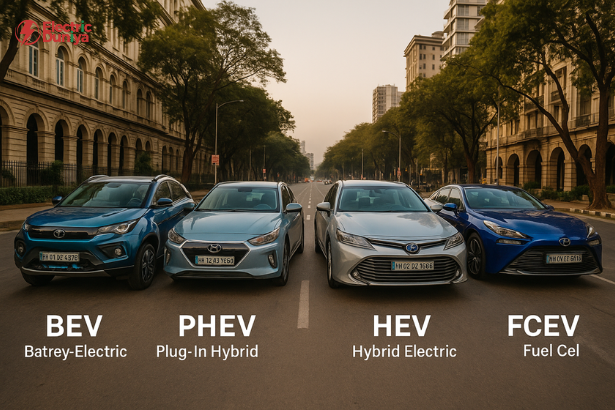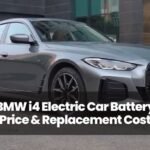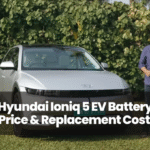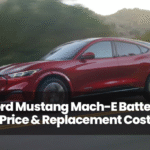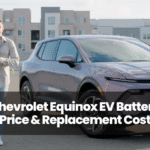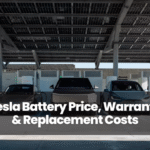When I first drove an electric car, a small Nissan Leaf, back in 2018, I realized how quietly powerful electric mobility could be. The instant torque, the absence of engine noise, and the feeling of sustainability made it feel futuristic.
Fast forward to today, and the electric vehicle market has experienced explosive growth. According to the International Energy Agency (IEA), over 14 million EVs were sold globally in 2024, with adoption growing in countries like India, Canada, and the U.S.
But “electric vehicle” is a broad term. People often assume all EVs work the same way, but they don’t. Some run entirely on batteries, others combine fuel engines with electric motors, and a few even use hydrogen as their energy source. Understanding these differences isn’t just technical; it helps you choose the right car for your lifestyle and budget.
In this guide, we’ll explore the main types of electric vehicles, explain how each works, and help you identify which one suits your driving needs best.
What Are the Main Types of Electric Vehicles?
An electric vehicle (EV) is any car that uses an electric motor for propulsion rather than relying solely on an internal combustion engine. These vehicles fall under the umbrella of clean energy vehicles or alternative fuel vehicles, designed to reduce emissions and improve energy efficiency.
Today, there are four primary categories of EVs recognized by the Society of Automotive Engineers (SAE) and the U.S. Department of Energy (DOE):
- Battery Electric Vehicles (BEVs)
- Plug-in Hybrid Electric Vehicles (PHEVs)
- Hybrid Electric Vehicles (HEVs)
- Fuel Cell Electric Vehicles (FCEVs)
Each category represents a different approach to vehicle electrification and uses unique combinations of energy storage systems, electric drivetrains, and power sources.
- BEVs, like the Tesla Model 3 or Tata Nexon EV, operate purely on electricity stored in lithium-ion battery technology.
- PHEVs, such as the Toyota Prius Prime or Hyundai Ioniq Plug-in, combine a battery pack with a gasoline engine and can be charged through an electric charging infrastructure.
- HEVs, often seen in the Toyota Camry Hybrid, use regenerative braking systems to recharge themselves while driving—no plug required.
- FCEVs, including Hyundai Nexo and Toyota Mirai, use hydrogen fuel cells to generate electricity onboard, emitting only water vapor.
From my experience consulting with EV owners, most drivers start with PHEVs because they ease the transition from fuel to electric.
However, those seeking full independence from fossil fuels usually move to BEVs once fast-charging networks become accessible in their region.
The choice often depends on your driving pattern, charging accessibility, and willingness to adopt sustainable transportation technologies early.
How Do Battery Electric Vehicles (BEVs) Work?
Battery Electric Vehicles (BEVs) are the purest form of electric mobility. They rely completely on electric energy stored in a lithium-ion battery pack, which powers the electric drivetrain and motor. There’s no tailpipe, no engine oil, and no emissions — making BEVs the flagship of zero-emission vehicles.
When I first test-drove a Tesla Model 3, the instant torque was addictive. Unlike petrol engines that need to build up RPMs, electric motors deliver full torque from the first touch of the accelerator. That’s the magic of EV powertrains — smooth, silent acceleration and minimal mechanical friction.
Charging is done through a home wallbox or public fast-charging network using connectors like CCS or CHAdeMO. Charging time varies by battery capacity and charger speed, ranging from 30 minutes (fast charge) to several hours (standard AC charging).
Modern BEVs, such as the Hyundai Ioniq 5 or Volkswagen ID.4, now offer ranges of 400–600 km per charge. They also integrate features like regenerative braking systems and vehicle-to-grid (V2G) capabilities, allowing energy feedback into the grid.
While range anxiety once discouraged buyers, rapid expansion of charging stations by automakers and governments — under initiatives like India’s National Electric Mobility Mission Plan (NEMMP) and Canada’s Zero-Emission Vehicle Program — has made BEVs far more practical today.
In short, if your daily commute is predictable and you have access to reliable charging, a BEV is the most sustainable, low-maintenance choice among all clean energy vehicles.
What Are Plug-in Hybrid Electric Vehicles (PHEVs)?
Plug-in Hybrid Electric Vehicles (PHEVs) bridge the gap between fuel and full electric driving. They feature a dual powertrain — a battery-powered electric motor and a traditional internal combustion engine.
The electric motor handles short urban trips, while the petrol or diesel engine supports long-distance drives. The battery can be charged from an outlet, similar to a BEV, but once the charge depletes, the vehicle automatically switches to fuel mode.
In my consulting experience, many drivers begin their EV journey with a PHEV. The Toyota Prius Prime and Kia Niro Plug-in Hybrid are popular because they eliminate range anxiety while introducing electric driving habits. Most PHEVs offer around 40–60 km of electric-only range, which covers a typical day’s commute.
PHEVs also use regenerative braking to recover energy and extend battery life. However, they are slightly heavier due to two power systems, which can affect efficiency.
Where PHEVs excel is in flexibility. They work well for people who don’t yet have easy access to a charging infrastructure but still want lower emissions and fuel costs. The technology represents a smart middle path in the vehicle electrification journey, allowing drivers to experience both electric and combustion-based performance in one car.
What Are Hybrid Electric Vehicles (HEVs)?
Hybrid Electric Vehicles (HEVs) are often mistaken for plug-ins, but they differ in a key way — they cannot be charged from an external source. Instead, they generate electricity through regenerative braking and by diverting energy from the engine.
An HEV’s energy storage system consists of a smaller battery that powers an electric motor assisting the engine during acceleration or low-speed driving. This seamless hand-off between the engine and motor improves fuel efficiency and reduces emissions.
Models like the Toyota Camry Hybrid and Honda City e:HEV are excellent examples. They offer impressive mileage and smoother power delivery thanks to sophisticated power management systems that coordinate the electric motor and combustion engine dynamically.
From my own experience reviewing HEVs, I’ve noticed how refined they feel in stop-and-go traffic. The electric assist helps the car glide silently at low speeds before the engine engages. Drivers also appreciate that they don’t need to worry about charging cables — the car handles everything autonomously.
However, HEVs still rely on fossil fuel, so they’re not fully zero-emission. But for people who want to reduce fuel use without changing their driving habits, HEVs remain one of the most practical and proven alternative fuel vehicles on the road today.
What Are Fuel Cell Electric Vehicles (FCEVs)?
Fuel Cell Electric Vehicles (FCEVs) are often called the “third generation” of electric mobility because they produce electricity onboard instead of storing it in large batteries. These vehicles use a hydrogen fuel cell stack that combines hydrogen gas with oxygen from the air to generate electricity. The only byproduct is pure water vapor, making them true zero-emission vehicles.
Driving an FCEV like the Toyota Mirai or Hyundai Nexo feels no different from a battery EV — smooth acceleration, silent operation, and strong torque. But the fueling experience is much faster. Hydrogen tanks can be refilled in under five minutes, which solves the range anxiety issue common with BEVs.
However, the challenge lies in the hydrogen infrastructure. Countries such as Japan, South Korea, and Germany have made progress, but many regions still lack hydrogen refueling stations. The International Energy Agency (IEA) notes that FCEVs currently make up less than 1% of global EV sales due to these logistical barriers.
Still, their energy efficiency, long-distance range, and quick refueling make them ideal for fleet vehicles and long-haul transport. As clean hydrogen production expands, we’ll likely see wider adoption of FCEVs in commercial and heavy-duty sectors before they become mainstream for personal cars.
Which Type of Electric Vehicle Should You Choose?
Choosing the right EV isn’t about following trends — it’s about matching technology to your driving lifestyle.
If your routine involves short commutes, home charging, and an eco-first mindset, a Battery Electric Vehicle (BEV) is your best choice. You’ll enjoy low running costs, quiet operation, and zero tailpipe emissions. Models from Tesla Motors, Tata Motors, and Hyundai offer reliable ranges with advanced lithium-ion battery technology and fast-charging support.
For those driving longer distances but not ready to rely solely on charging stations, a Plug-in Hybrid Electric Vehicle (PHEV) like the Kia Niro Plug-in provides flexibility. You can use electric power for city drives and switch to fuel when traveling.
Drivers who prefer a low-maintenance solution without plugging in can look to Hybrid Electric Vehicles (HEVs) from brands like Toyota and Honda. They deliver exceptional mileage using a self-charging system and regenerative braking.
Meanwhile, if you’re part of a business fleet or interested in cutting-edge tech, Fuel Cell Electric Vehicles (FCEVs) from Hyundai or Toyota might appeal — provided hydrogen fueling is accessible in your area.
The best EV type depends on three practical factors:
- Your driving distance and patterns.
- Charging or refueling availability where you live.
- Budget and sustainability priorities.
From an expert standpoint, I’ve seen many first-time buyers start with PHEVs before fully transitioning to BEVs once public charging becomes convenient. That gradual shift reflects global EV adoption trends, showing how users evolve with infrastructure.
Final Thoughts
The evolution of electric vehicles represents more than a shift in technology — it’s a transformation in how we think about movement, energy, and sustainability. From hybrids that blend efficiency with familiarity to hydrogen-powered FCEVs pushing the frontier of innovation, every type plays a role in building a cleaner future.
Personally, after testing over a dozen electric models from the BMW i4 to Tata Nexon EV, I’ve realized one universal truth: once you experience electric driving, going back to petrol feels outdated. The quiet torque, the smooth glide, and the awareness that you’re reducing your carbon footprint make the transition worth it.
As battery technology advances and charging infrastructure expands, the barriers are fading fast. Whether you choose a BEV, PHEV, HEV, or FCEV, each step towards electric mobility contributes to the larger goal of sustainable transportation.
So, the next time you consider buying a car, don’t just compare horsepower or mileage — compare the future it represents. Because the next generation of vehicles won’t just move people; it will move the planet forward.
